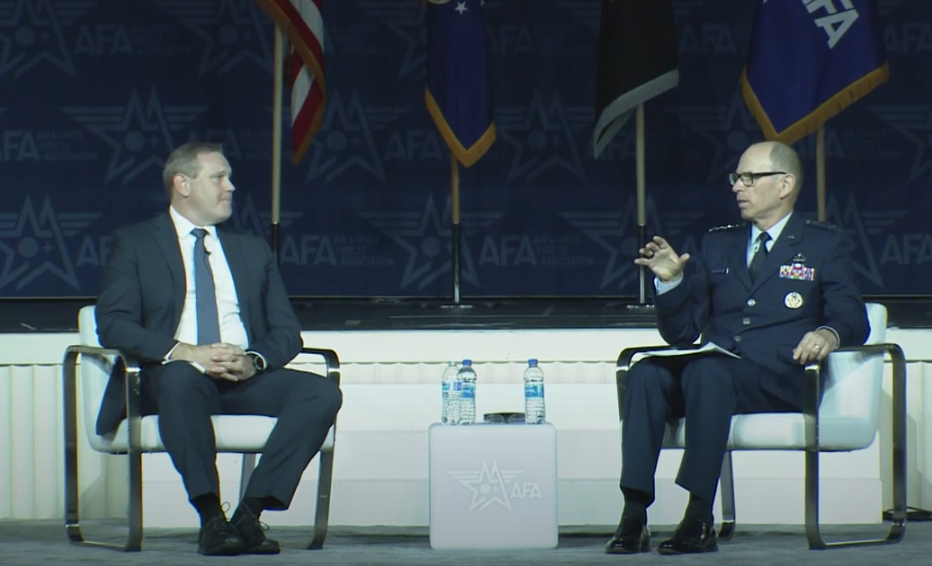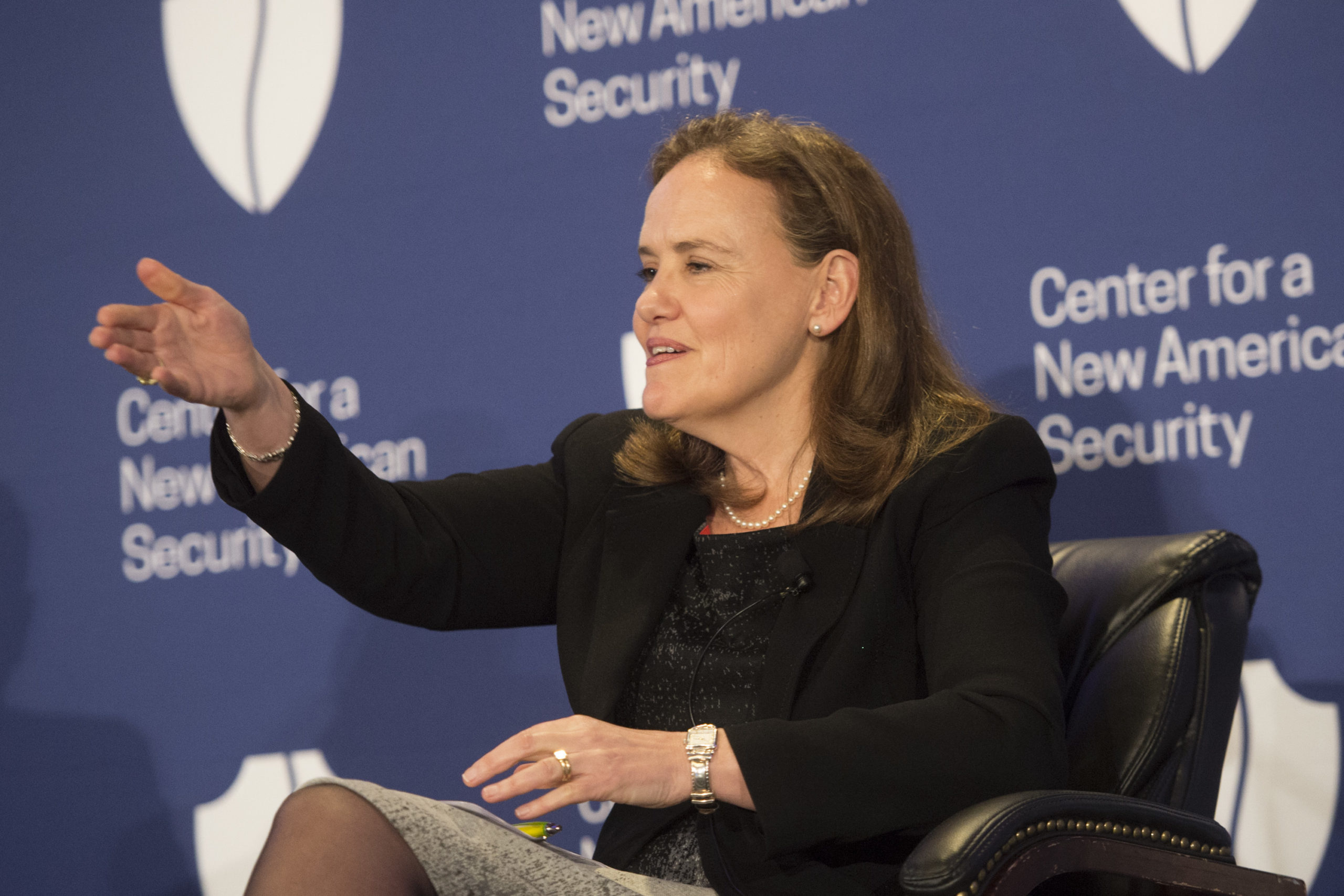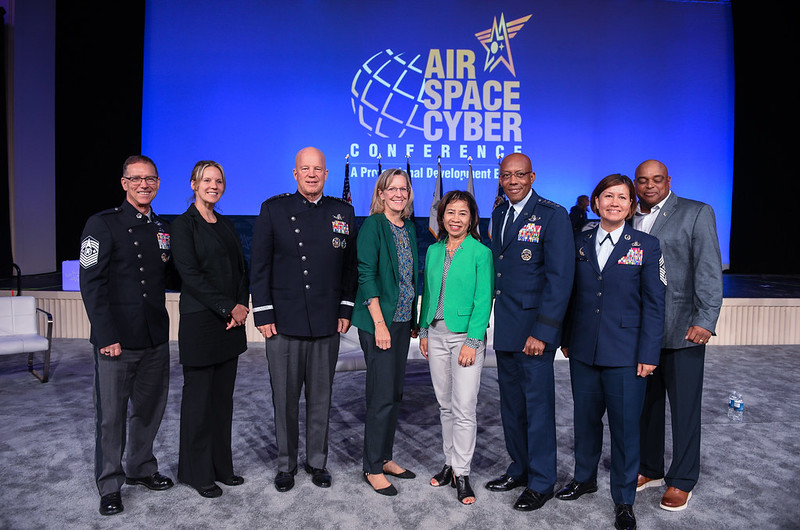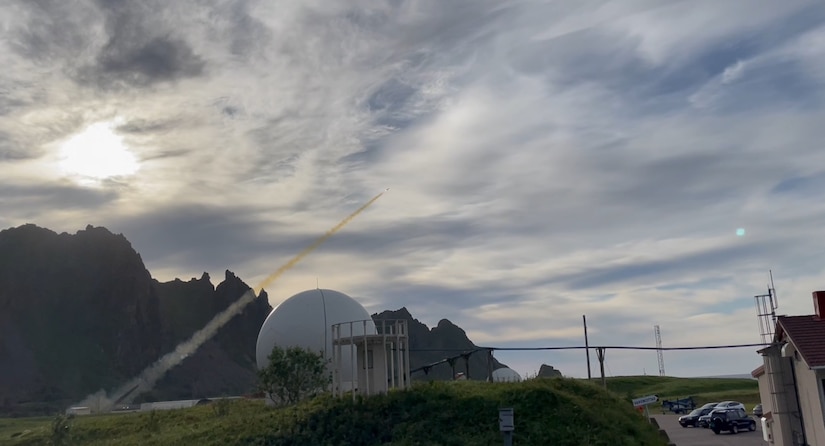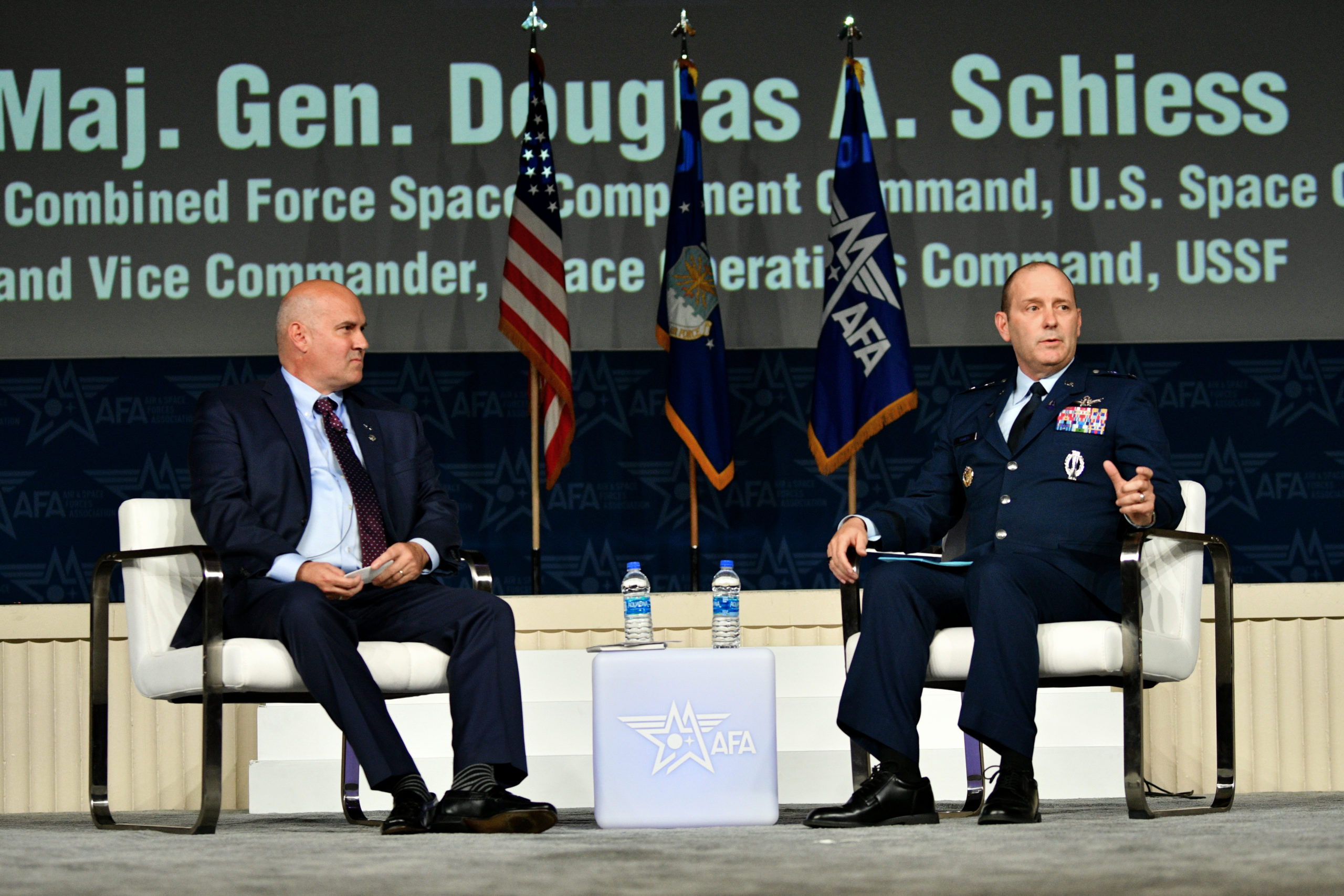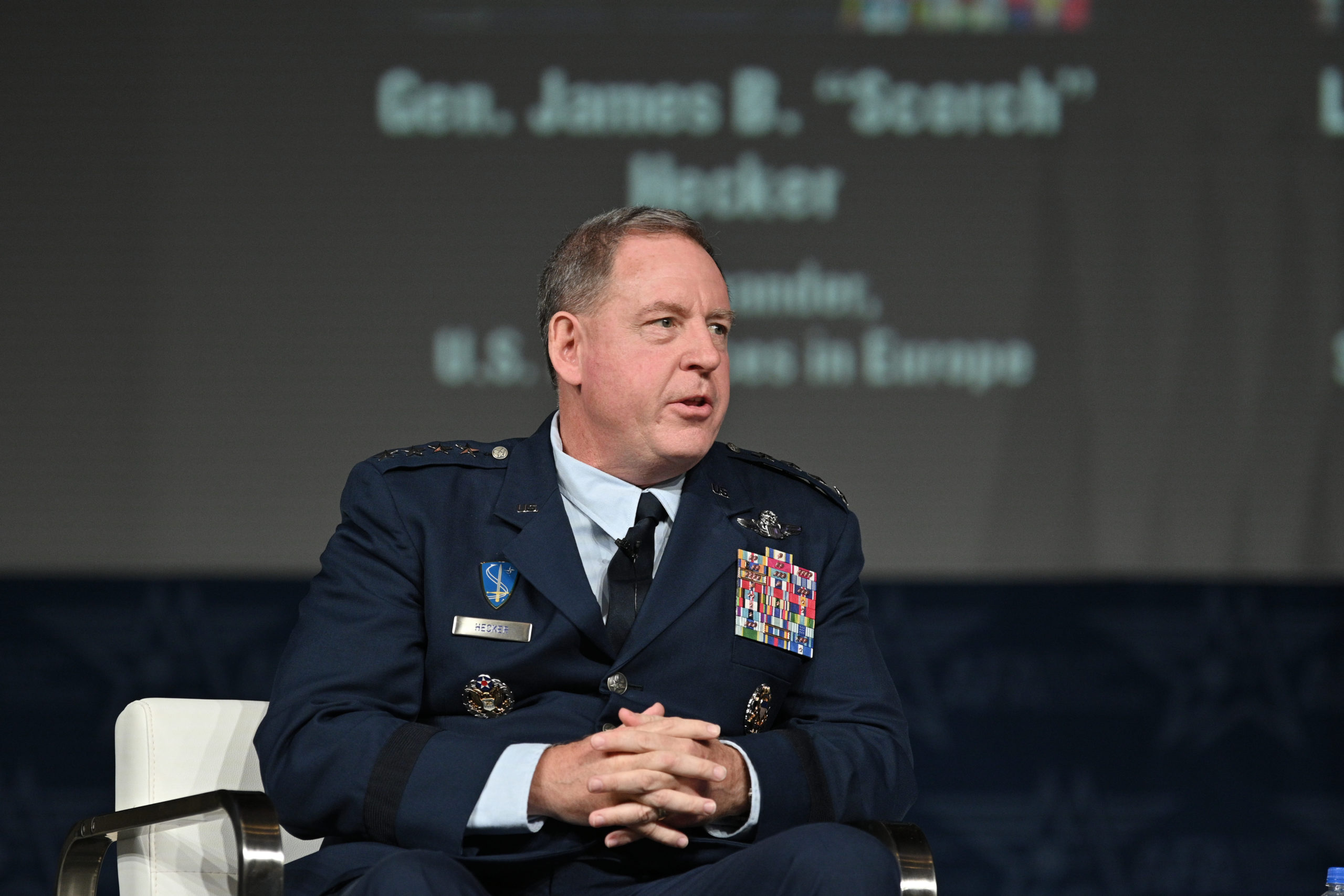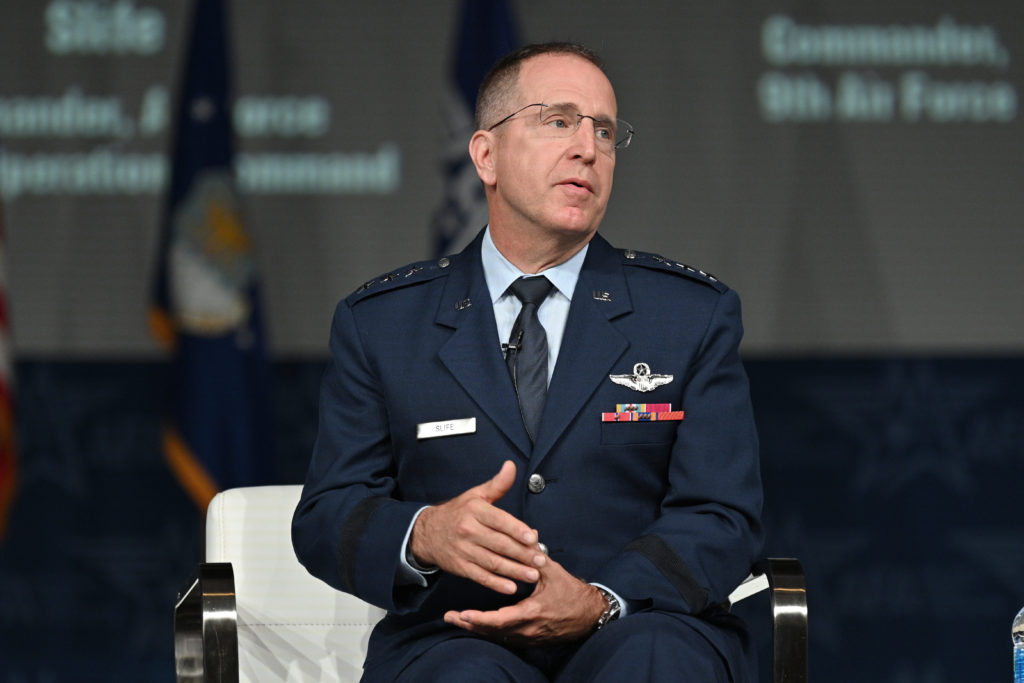Retired Chief Master Sergeant of the Air Force Kaleth Wright leads a discussion with Gen. Jacqueline D. Van Ovost, commander of U.S. Transportation Command; Lt. Gen. Richard M. Clark, superintendent of the U.S. Air Force Academy; and Maj. Gen. Edward W. Thomas, commander of the Air Force Recruiting Service on “One Team, One Fight: A Force Multiplier” on Sept. 20, 2022, at AFA’s Air, Space & Cyber Conference. Watch the video or read the transcript below. This transcript is made possible through the sponsorship of JobsOhio.
If your firewall blocks YouTube, try this alternative link instead.
Voiceover:
And now please welcome to the podium, the 18th Chief Master Sergeant of the Air Force, Kaleth Wright.
CMSAF Kaleth Wright, USAF (Ret.):
All right, well good afternoon teammates. It’s good to be back amongst so many familiar faces and even some new faces. Today’s panel is titled, One Team One Fight, A Force Multiplier. So today we’re going to talk a little bit about diversity, equity and inclusion. And so let me begin by introducing our panel members. On my far left, we have Major General Ed Thomas, who is the Commander of Air Force Recruiting Service and he’ll be talking about diversity, equity and inclusion from a recruiting lens.
Maj. Gen. Edward W. Thomas:
Thanks, Chief.
CMSAF Kaleth Wright, USAF (Ret.):
We also have Lieutenant General Rich Clark, who is the Superintendent of the US Air Force Academy and he’ll pick … Okay. Yep. And he’ll pick up the discussion from a developmental and building the force perspective, General Clark.
Lt. Gen. Richard M. Clark:
Thanks sir.
CMSAF Kaleth Wright, USAF (Ret.):
And finally we have General Jackie Van Ovost, who is the Commander of US Transportation Command. And she’ll be making linkages to both the operational and strategic imperatives for having a more diverse and inclusive joint force. I think this promises to be a very informative panel. So thank you all for attending. Let’s start to the discussion with each of our panel members and just providing their perspective. So, General Thomas.
Maj. Gen. Edward W. Thomas:
Hey, Chief Wright. Thanks so much. Pleasure to be here, pleasure to be with you again. One of my wingman and battle buddies here in my last assignment, General Van Ovost and General Clark, humbled to be on the panel with you.
There are so many things that I would love to be able to say about recruiting and how we get after recruiting and diversity, but I’m going to try to keep it brief. Let me start with this. Back in 2017, I was on a trip with the Chief of the Secretary going through the Middle East and we had a New York Times author and columnist, Tom Friedman, that was on the trip with me, I’ve really gotten to know Tom well over the years. And I got to see our Air Force, after at the time having been in it close to 30 years, through just a little bit different lens. And to have this civilian on the trip watching the kind of Airmen that we had all throughout the theater, whether it was Al Udeid or Al Dhafra in Afghanistan or Iraq.
And he was visibly moved and humbled by the kinds of Airmen that we had from all walks of life. And he came out of that trip just a little bit amazed at how they all came together, even as our nation dealt with issues that were divisive, he didn’t see any of that out on the front lines or in the theater. And he compared it to our traditional US motto, “E Pluribus Unum”, out of many, one. And he described these Airmen from all demographics, from all walks of life, how they pulled together and how they made one American clenched fist for the nation. And it was refreshing to me to see our Air Force again through this lens of an outsider and what it meant.
So from my perspective, leading recruiting for our Air Force and our Space Force, let me just real quickly, just give you two whys. The first is, why recruiting? This is the easiest and the simplest. Because I would argue that recruiting the best and the brightest Airmen from around the country is the single most significant factor in combat radius. That’s the first one. Okay. So the one that’s been a little bit harder and it’s been an interesting journey over the past couple years, explaining this to people and helping them understand it is, why diversity? “Okay, recruiting I get, but why does diversity matter?” Well, I’ll tell you in my mind, there there’s two key reasons. Some of this you can look at as idealistic or pragmatic, I think it’s both as the recruiting commander, very pragmatic for me.
Generation Z is the most diverse generation ever in American history. So if we’re going to get after and recruit the best of our citizens from all across the United States, the only way we’re going to be able to do that is to be able to do intensive outreach and be able to connect in meaningful ways with folks from all across America in every demographic. And we have to be deliberate about it. That’s the combat readiness piece of it.
The second piece of it, as we serve, we’re in a military who serves in a democracy. We serve the American people. So from a historical, from a military sociological perspective, if we do not look like the country we serve eventually, including our rated, including our leadership ranks, that’s going to eventually be, that’s going to be a problem. And not only do we risk having the best, most combat ready Airmen, because we’ve truly pulled out and called the best, we also risk a further division in our nation where we’re already struggling with somewhat of a sieve mill gap.
Okay, I’ll just end with this though. The best thing we still have going that excites me every day, that makes me love my job, I’ve got one of the best jobs in the United States Air Force, is we’ve got an unbeatable value proposition. We’ve got an unmatched opportunity for people to come join us, to come be part of something bigger than themselves and be part of that American clenched fist. Back to you Chief.
CMSAF Kaleth Wright, USAF (Ret.):
All right. Thank you, General Thomas. General Clark.
Lt. Gen. Richard M. Clark:
Okay. Well, thank you Ed. And General, it’s so good to be back up here with you as well, two long time friends, real honor. And certainly Chief Kaleth Wright, everybody’s hero. So it’s great to be here. Thank you, Chief.
So from USAFA perspective, diversity and inclusion has to be woven throughout everything that we do and that is an imperative for us. And when we talk about our priorities at the academy, I think that’s probably the best way to share with you just how important it is, not only to us but our Air Force, our Space Force, our country as we’re developing leaders. And our number one priority has always been to develop leaders of character. That’s the number one, that I say, the prime directive of the Air Force Academy.
And when we talk about developing leaders of character, we start with our core values, right? Integrity first, service before self, excellence in all we do. But there’s an ancient Chinese philosopher who really helped us to line this up with a quote that I’m sure many of you are familiar with but it starts with, “Your thoughts become words, your words become actions, your actions become habits, your habits become character and your character’s your destiny.” And we have to start with character.
So when we think about the thoughts and the words of integrity, service and excellence, they lead us to the actions and habits that we want to see from our cadets. So for, when we talk about integrity first, that leads us to honorable living. People that live honorably in everything they do, no matter what it is, where they are, whether someone’s looking or not, they live in an honorable way.
When we talk about service before self, we want to see a leader that lifts other people to be their best possible selves. No matter what they look like. Whether they look like them, come from the same city, country, wherever it is, we want those people to lift everybody else around them, even if it means that they have to sacrifice themselves to be their best possible selves.
And when we talk about excellence in all we do, that’s about elevating our performance. Every day we have to be better today than we were yesterday. And that means that we have to look at our team as a whole and help our teams get better by creative thought, by innovation, by doing the things that diverse teams bring to the fight. And it’s scientifically proven that diverse teams make better decisions, that they can think more creatively and innovatively. So, developing leaders of character is first and foremost, and diversity and inclusion is core to that.
Our second primary, our priority, is to ensure that we are preparing our leaders for future conflict. They have to be able to go out, not just five years from now, but 15 or 25 years from now, to be able to fight and win our wars as warriors. They have to solve problems that we don’t even know about yet. They have to be able to present problems to our adversary that they won’t be able to handle. But in order for us to be able to do that, we have to be able to, just like General Thomas just talked about, we have to be able to glean talent from across our country. We have 435 congressional districts, diverse districts that we have to bring the best of the best in. And it is a strategic imperative for us to be able to do that, to bring them into our academy so that they can be a part of a team that understands what it means to lead into the future.
But here’s the thing, if our cadets don’t understand, if they don’t understand how to lead people that don’t look like them or think like them, our country is only getting more diverse every day. And if we want to fight with 30 or 40% of our population, then let’s keep doing that. But if we want to use 100% of America’s power, then we have to be ready to lead with all of America. If we’re going to defend America, we need to look like America. So that is the number, the second priority that we have to be prepared for future conflict.
And the third one is to inspire a culture of dignity and respect. And that is something that encapsulates everything about diversity and inclusion, but really just about being a leader and about being a great fighting force. And diversity or dignity and respect is something that we instill in our cadets from day one. But I had a video that I wanted to show you, because I could give you a hundred words, but in two minutes I can really show you what we believe about dignity and respect. And I hope that that video is teed up so that we can show it to you. Is that possible? It is.
Video:
We don’t rise every morning and hope to do the same things we did yesterday. We don’t resolve to remain the same. Our minds expand with every person we meet, every place we travel and every time we step outside of our comfort zone. The more we grow, the farther we dare to go. The only question is, how far will that be?
We come to the Air Force Academy because we want to be a part of something bigger than ourselves. We want to be challenged like never before. We don’t expect it to be easy, we don’t even want easy. In 1955, Air Force Secretary Harold E. Talbit said, “The academy is a bridge to the future.” This bridge is not laid out in front of us like a red carpet, it’s a long blue line started by the cadets who have come before us. We look to it to see how far we’ve come, but also to acknowledge how much farther we have to go.
As a nation, we’ve always fought for freedom, but we still struggle to guarantee equality. We’ve seen what happens when we fail to listen to each other and worse, when we don’t even try. Our academy is not perfect either.,Our history is proof. Until the seventies, we only had a handful of cadets of color in any class. It took 20 years and a presidential order for us to admit our first woman. Some of us have experienced racism or heard inappropriate jokes in our halls. These failures weaken that long blue line. Where we go from here is up to us, because with every failure there’s opportunity. So let’s take a long hard look at ourselves, have the tough conversations and lead the way. The more willing we are to understand and respect backgrounds and beliefs that are different from our own, the stronger we’ll become. This ideal is not a finish line, it’s a north star we follow.
The faces around here have changed over the years, but our graduates have always inspired others. They have fought bravely in wars, stood on Olympic podiums, served in Congress and flown in space. These achievements are a testament to our own potential and inspire us to aim higher. Soon we will have the opportunity to be the new faces leading the way and they will be the most diverse to date. Some call that progress, but it’s just the beginning, because we can’t represent the best of America if we don’t look like America. We can’t defend the rights of every citizen if we don’t stand up for the rights of our fellow cadets. If one of us is disrespected, we are all disrespected.
The academy is a pillar of leadership. Airman have led our society before and we must lead the way today. We have the power to shape what the Air Force and Space Force become, our fellow Airmen and Guardians are counting on it. It’s an incredible honor, but an even bigger responsibility. The academy helps cadets to live honorably and to become the leaders our country needs. It’s up to us to show the world who that is. We’re taught to always look to the future, but first we need to recognize where we are right now. We can’t move forward without looking at where we stand. So let’s stand for each other before anything else. The more we treat each other with dignity and respect, the higher we’ll rise. They say it’s lonely at the top, but we wouldn’t know because we’re all up here together.
Gen. Jacqueline D. Van Ovost:
Nice.
Lt. Gen. Richard M. Clark:
So I’ll end there, but I just want to say one more time, those priorities, developing leaders of character, preparing for future conflict and inspiring a culture of dignity and respect. Thank you. All right. Ma’am.
Gen. Jacqueline D. Van Ovost:
That’s nice. Yeah. Gerald Clark, Major Thomas, wingmen. And I know you were all here on the late session on a Tuesday to see Kaleth Wright though, and that’s actually why I came as well. So what a great video. I don’t have a video, I have a slide. But first of all, thanks for an opportunity to come up here and talk a little bit about the effects of diversity inclusion to the joint force and frankly to our allies and partners. As I think about lethality, that is the bottom line for diversity, equity and inclusion a lethal, agile and resilient joint force. But a joint force that can manage the strategic environment and these complex situations, as General Clark talked about, that we need all these diverse minds to get after in these diverse experiences.
But I’ll take it a level further because we have to be able to integrate with our allies and partners. If we don’t understand our own culture and our own people and our own development, how is it that we can be that shining beacon on a hill? And how can we better and how we have to do integrated deterrents and increased relationships and interoperability with our allies and partners if we can’t lead ourselves, right? Because they represent those different cultures.
So, I wanted to talk about, throughout histories there are plenty of battles where the military force lost because they did not represent the people, the nation, the tribe that they fought for. And I commend you to a book from Jason Lyle, where he, it was called Divided Armies. And he looked back in the last 200 years on battles around the globe. And what he did, was he linked the citizen status within the nation and in their military to battlefield performance. So it was very interesting and I commend you to read it, but spoiler alert, internal discrimination leads to battlefield defeat. You don’t see any of those results when you have a more inclusive force. So that’s what we want to avoid, is over time if we don’t have that diverse, recruit and train, we could be in for failure into the future. So it is a strategic imperative that we have and raise an army that is reflective of our nation and reflects the core value for which our nation was founded. Around the world we’re looked at to be that beacon and we need to act that way.
So, I want to think about, how is it that, concretely, that we’re watching how diverse and frankly all of our actions we’ve been taking to ensure that diverse communities are more welcome and that we remove friction areas and we have a better understanding of what they’re like when they’re in the force and how we have to develop them. So a couple of [inaudible 00:18:38], we have seen results at the strategic, operational and tactical level.
So I’m going to start with one tactical level from the female side. Lieutenant Colonel Melissa Donbrick, and I think we may have a slide if we could. She’s an OMSAD scholar and she was the first American, much less woman, to graduate from the University of Rabat in Morocco. So courageous to go into that culture and get a master’s degree. She then became the 76 Airlift Squadron Commander. And during her pregnancy she wanted to fly for Operation Allies Refuge. So she sought a waiver and got the waiver to fly. And not only did she fly in and supported the missions, she was also the air boss pulling midnight shifts managing the flow into Ramstein Air Force base. So here we have an Airman that not just provided readiness to her unit, but she provided one heck of example of a leader in a contested environment that’s making a difference.
And speaking of making a difference, on a side note, you should ask her what her experiences were like between her first child and her second child. And between those two times, we instituted a lot of policies to support women and pregnancy and maternity flight suits and hair and fitness that made her experiences completely different. So someone who really can appreciate all of those policies we’ve worked together and that’s just in [inaudible 00:20:12] on the women’s initiative team. But we’re working, [inaudible 00:20:15] analysis working groups all the time and they are making a difference. And I thank all of you have been involved in those.
And now let me talk about at the strategic level. So it’s not just in the Air Force, across the Department of Defense we have a program called Women, Peace and Security and we’ve deployed gendered advisors to support the Afghan refugees flow, really to communicate and support them as they were going through the process. And this program is led by the combatant commands. So we send out officer enlisted leaders to go to different countries to help them understand better how to manage all of their resources and how to be more effective as a team in leadership. And it’s making a difference. We send out from the Air Force and what I do in AMC, they send out MCSs that do that work. But Chad, Ghana, El Salvador, it’s making a huge difference.
Again, it’s American leadership and when we can do it right here, we are that beacon and we can translate and show those policies and show them the way that they can do it. Indeed, we have a very strong program in South America and just last week in Columbia they announced that their next senior enlisted advisor to the chief of defense is a female. That’s a huge step there. And they get support when they see our policies, we do workshops to show them how to fix things, to make a fulfilling career in the military for them, not just with women but all of their minority groups. So it’s really great, it provides us opportunities, again, to thicken those relationships with our allies and partners because they are our strategic advantage.
And just like we want to use a 100% of what is in America, we want to use a 100% of what our allies and partners can bring to the fight every day and it truly makes a difference. So as I think about, it takes this team from recruiting all the way to force development to continued development in your career, to then showing our allies and partners what it is we can do. And that’s the value factor for what we’re talking about. So thanks. Thanks here Wright.
CMSAF Kaleth Wright, USAF (Ret.):
All right, thank you. So General Clark, in the video, amazing video by the way, so thank you for sharing with us. At one point it said, “If one of us is disrespected, we’re all disrespected.” And I was wondering if you could share a personal story of when you were disrespected and how you handled it?
Lt. Gen. Richard M. Clark:
I get disrespected every day, but let me… No, but-
Gen. Jacqueline D. Van Ovost:
Your kids do?
Lt. Gen. Richard M. Clark:
… Yeah. No, my kids are gone, I’m still getting disrespected. But no, I think about Chief, think back to pilot training and there was an incident there that I started out, out of the academy, I had a great team that I was studying with, that we had a study group that we shared. And one night we decided we were just going to take a break, play some cards, hang out a little bit and we were at another guy’s house, one of our fellow students and his wife brought out their dog and the dog’s name was Rudy. And I said, “Hey, why Rudy?” And she goes, “Oh, we named her after Rudy on the Cosby Show.” And one of the guys that was in my study group said, “Rudy, from the Cosby Show, she’s just a ugly old…” N-word. And I was like, “Did he just say that?” And it was, at first it shocked me, but then the next thought that went through my mind was homicide. I was thinking, “I think I have to take action here.”
But I took a breath and I stepped back and I said, “I can’t believe you just said that.” And he said, “Oh, don’t take it so personally.” And of course I was the only black man, only black person sitting around the table and we had a couple words, I won’t repeat them. And then I said, “I have to go.” And I left. And from that point on, I couldn’t be a part of that study group anymore. And that, in the early stages of pilot training is detrimental. But then two of the guys that were sitting around the table came to me later and said, “Hey man, we should have said something there, but we want you to come back into the study group.” And I thought, “I can’t, not while he’s there.” And they said, “He’s not going to be there, but we want you to be there. Come back into the group.” And it just, for them to reach out and pull me back in and to realize the wrong that was done there meant everything to me and I remembered that.
Fast forward to 2003, I’m a Squadron Commander and we deployed for Operation Iraqi Freedom, B-One Squadron. And I’m in my tent one day and we had built our crews very deliberately and I had a crew with one of our amazing instructor pilots, I’ll just say her name was Tank, just to keep names out of this. But her name was Tank. Tank was fantastic. And she had a wizo on her crew that was an older guy who I had known for a long time. And one day that wizo came into my tent and he said, “Hey Rich, I can’t fly on this crew. I can’t fly with a woman in combat because I don’t buy into that, I don’t agree with that and I just want you to move me to a different crew.” And I started getting this hot feeling in my head and I’m thinking, “Man, this is going to be my first combat kill because I’m about to do this guy in.”
But then I thought about it and I had two choices. It would’ve been real easy just to move him to another crew and nobody would’ve been, nobody would’ve known. But I think back to those guys that stood up for me when I needed someone to step up and say, “That’s wrong.” And I said, “No man, I’m not moving you off that crew and you have two choices.” I said, “You can either go home with paperwork that describes your dereliction of duty or you can fly the mission as stated. And I will tell you this, that you’re on the crew with Tank for a reason, because she’s going to save your life.” And he said, “Oh. Don’t…” And I said, “No, those are your choices.” And he said, “Well, I didn’t mean for it to get all like that.” And he left and he flew a Tank.
Well, two days later they flew on a mission. And in that mission, first when they took off they had an engine problem, they had to circle back and land the airplane. And while they circled back, Tank arranged for a spare aircraft to be brought up, they left that aircraft that they were in, they moved to a spare aircraft, they took off, they had troops and contact, they delivered their full load of 24 joint direct attack munitions and they probably saved 50 to a hundred lives because there was, during that tick that troops and contact. That crew was decorated and Tank really did probably save, if she didn’t save her crews life, she certainly led to the saving lives of other Americans.
And to his credit though, that wizo came back later and said, “I got to tell you, I was wrong. Tank’s a hero and I’m glad that I was on her crew. That was the best experience I’ve ever had in an airplane and I appreciate it.” To his credit, he realized the err of his ways. But to Tank’s credit, she showed him the err of his ways. And that’s what we need to do, two things. First, we need to stand up for each other, we need to stand up for each other. And I thank those guys that stood up for me to lead me to stand up that day as a Commander. And then, when people don’t want to stand up for us, it’s up to us to show them what we’ve got, as a country, as a force, that diversity does matter and it does help us. So, that was my one example Chief.
CMSAF Kaleth Wright, USAF (Ret.):
Thank you sir for sharing. General Clark was a football player back then and he was probably a lot bigger. So, I’m going to speak for those two guys and say they probably didn’t want that smoke. General Van Ovost, one of the things that we’ve heard and we experienced after the George Floyd incidents was the difficulty for leaders in the Air Force to talk openly about diversity, equity and inclusion issues. What are your thoughts and what ideas do you have on how we can talk openly and candidly about the challenges faced, particularly by minority populations inside the Department of Defense?
Gen. Jacqueline D. Van Ovost:
Yeah, thanks K. Wright. Look, not just after George Floyd, but along the same lines. The Air Force did a lot of soul searching, did a lot of data digging and we had real examples, real data that said we weren’t doing it right. So to the credit and I credit the leadership of the Air Force, first thing they need to do is own it. Own the problem. And that requires a lot of self-reflection, a lot of, “Where was I, when?” But you own the problem. There’s a reality of the data. And then as you… Don’t chip away at it with, “Well, it was the wrong assumption.”, or, “It just was one person on the diox that was mad, everybody else was not.” Take it for face value. Listen for understanding, listen with empathy, hear the stories. And you will find as, even as the first level supervisor, there are things that are not in your wheelhouse, you’re like, “Well, I don’t know how to change that.” But it doesn’t mean that you let it go. You have to elevate it. You have to get everyone involved in what the concerns are with the policy or process or the data and so that you can really bring it up and come up with different solutions.
So you may not own the problem because it could be some sort of corporate promise or some sort of policy problem, but you own the solution. Why do you own the solution and you don’t own the problem? You own the solution, because again, it’s all about readiness, it’s all about taking care of your people. So if we’re going to take care of our people, we’re going to own that problem. And by owning it, I mean again, ring the bell, elevate the problem, let’s have a discussion about it and lay it flat. Because as a commander at any level, it’s terrible to hear something discriminatory that occurred on your squadron that you didn’t know about had been going on for months. That’s happened to me once and you’re like, “Oh my gosh, why didn’t you tell me earlier? Why did we let this propagate? Who walked by this? Who should have known? Who should have acted?” But own it and walk around you own it and listen for empathy.
CMSAF Kaleth Wright, USAF (Ret.):
Thank you ma’am. So General Thomas, you’ve been criticized for-
Maj. Gen. Edward W. Thomas:
A lot.
CMSAF Kaleth Wright, USAF (Ret.):
… for lot, for lot, but specifically by a network anchor, we won’t mention which network for your recruiting, lowering recruiting standards, allegedly and for being too woke when it comes to diversity, equity and inclusion. Does recruiting focus on diversity somehow put, weaken the military or put our overall readiness at risk?
Maj. Gen. Edward W. Thomas:
Yeah, thanks for that question Chief. No, look, unconditionally no. Unconditionally no. This is a red herring, it’s a distraction. To just give plain Aggie speak here. At the end of the day, our job is to be prepared to kill bad people and tear up their stuff. War fighting has got to be and is mission number one. So just briefly, here’s how I explain it because this is the part that really just kind of rubs me wrong. Is people, when I said this has been a bit of a journey explaining diversity, because here’s what people hear sometimes. “Hey, we’re really thinking through diversity, how we’re a diverse force, how we draw the best.” Here’s what they hear, “You want to drop standards. You just want to put quotas out there so you have different flavors of people in our Air Force.” That is so absolutely wrong.
There’s two main things we do in recruiting. We attract and we select. Picture this, this big circle, attract. We go and we throw a wide net out across America. We want them to be part of us, like a football team, like any athletic organization. “Hey, come try out for the team. Think about wearing our jersey.” But then, we select the best athlete, who throws the furthest, hits the hardest, because that’s what our organization is about. And these Airmen out in uniform today, they’re here because they made the team not because of any other reason. And we’ve got to make sure people understand that piece. So thanks for the questions Chief.
CMSAF Kaleth Wright, USAF (Ret.):
Thank you. Thank you, sir. All right. We’re getting close to our time, but General Van Ovost, I wonder if you can talk a little bit about any positive steps that the Department of Defense and the Air Force has taken to incentivize women to continue to serve in the military?
Gen. Jacqueline D. Van Ovost:
Yeah. First of all, I’m proud of everyone that’s working on our bear analysis working groups, whether it’s Indian American, the Heat, our Hispanic team, the wit, they’re making real strides in both major policy changes and just getting rid of some irritants that don’t allow us to really serve and get that fulfilling service that we really desired when we joined in the Air Force. I think it makes a difference. I think it makes a retention difference and that turns into a recruiting difference. So congratulations to everyone and keep working. Why? Because our culture continues to change. And Gen Z will bring in some new challenges to what we’re thinking, the next generation will as well. And we should continue to change our policies and procedures to ensure that they can serve at the highest level and give us the very best talent of America.
So between our career and our mission, the pregnancy waivers that we have, our ability to relieve ourselves in flight, it’s an improvement. But the fact that we are investing small resources to ensure that we’re comfortable throughout all phases. And then I think about childcare. It’s hard, it’s Milcon, but I tell you that I appreciate the secretary. He’s been trying to prioritize childcare Milcon and then it’s about getting into and getting more people to take care of the children. So, it’s the people side as well. And so, he’s investing in some of the people side and some contracts.
So that, all the biggest barriers as we grab the information from when people leave the Air Force and grab that information about what were the main determinants or why’d you make these decisions, the flash to bang, on understanding that and then rolling it into one of these work groups and then getting after it. I think we are absolutely leading for the Department of Defense. And again, our work that’s here is not just for America’s military. We are taking this stuff overseas in our Women Peace and Security, not just for women, but for minorities and trying to promulgate that information. So keep at it.
CMSAF Kaleth Wright, USAF (Ret.):
Excellent. All right. That’s about our time today. There’s lots and lots of things that we can discuss in this conversation. I encourage each of you to continue having these tough conversations about diversity, equity and inclusion.
I want to, especially, I want to thank each of the panel members, not just for being here today and sharing some of their personal insights, but for being role models when it comes to diversity, equity and inclusion. I had a chance to personally work with each one of them and they practice what they preached. They all had very diverse staffs. They engaged on issues of diversity, equity and inclusion, at least during the time when I was serving, I didn’t see General Clark knock anybody out at the time we were serving. But it does mean a lot. It’s one thing to talk about it and it’s certainly another thing to actually practice it and be role models for all the people who look up to each of you. So thank you once again for being here. Thank all of you for sticking around to hear at least a part of this conversation. And again, I encourage you to continue having the tough conversations around diversity, equity and inclusion. Thank you.



